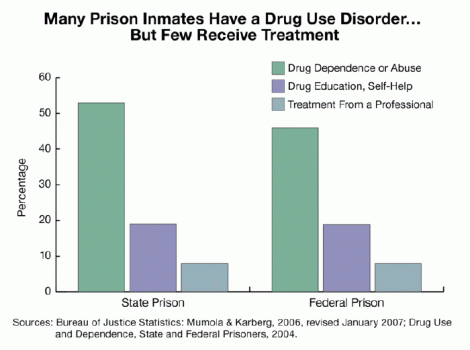 In this video, Dr. Chandler explains what her Branch does and the ways in which her work is rewarding.
In this video, Dr. Chandler explains what her Branch does and the ways in which her work is rewarding.The chief of NIDA's Services Research Branch talks about drug abuse treatment within the criminal justice system, and expresses hope that health care reform will strengthen the drug abuse treatment system.
NIDA Notes: Why is the criminal justice system a key focus for efforts to reduce drug abuse and addiction?
Dr. Chandler: An estimated 60 percent of the individuals in the criminal justice system have substance abuse problems severe enough to warrant treatment. In addition, individuals are often under the influence of drugs or alcohol when they commit crime. Therefore, there is a great deal to be gained from providing effective treatment to this population. From the public safety point of view, we would anticipate lower recidivism, less cycling of individuals through the criminal justice system, significant cost savings, and safer and more stable communities.
NN: Has the criminal justice system embraced this treatment role?
Dr. Chandler: The criminal justice system has traditionally not prioritized treatment. The system exists to protect public safety and has typically viewed drug abuse and addiction not as health problems to be treated, but as punishable offenses. As a result, where treatment is offered, it seldom features the elements that research shows are necessary to achieve lasting results. For example, we know that the key to effective treatment is equipping people with self-management skills to cope successfully with their addictive disorders. Yet the most common type of program offered to offenders is drug education. These didactic sessions describe the various types of drugs and their effects on the body and brain, but don’t teach or provide practice in any new skills.
The offender population and criminal justice settings present unique issues and concerns with regard to treatment. As one example, methadone and buprenorphine are proven effective therapies for opiate addiction but are not widely accepted by criminal justice administrators. They have been wary of offering these medications, partly because of concerns about potential diversion and discipline problems in their facilities.
However, addressing drug abuse and addiction within the criminal justice system can be uniquely advantageous. For example, one of the greatest challenges in community drug abuse treatment is keeping people in programs long enough to achieve efficacy. In the criminal justice system, courts and probation officers can require individuals to adhere.
The public health and criminal justice systems have historically been bifurcated, but by working together, they can significantly enhance both of their missions. Our division is developing a research base that strives to combine and leverage best practices in both public safety and public health. (See Dr. Chandler’s paper, “Treating Drug Abuse and Addiction in the Criminal Justice System: Improving Public Health and Safety.”)
NN: What are some potentially fruitful coordinated practices?
Dr. Chandler: One that is already implemented in a number of places is drug courts. Judges in these venues offer drug-involved offenders who don’t pose serious public safety problems the option to avoid incarceration by completing treatment in the community. The chance to remain in the community is a strong motivator to stay in treatment. The treatment program keeps the court informed, so that if the offender stops attending or making progress, the court can reinforce his or her motivation with new sanctions—for example, more frequent urine testing, time in jail, or in some cases incarceration. The drug court arrangement relieves some of the pressure on the court and prison systems, and it reduces the disruption of offenders’ and offenders’ families’ lives. Drug courts have been extensively evaluated and deemed effective in getting people access to treatment, reducing drug use, and decreasing criminal activity.
Anti-addiction medications are another area where public health and public safety might coordinate to everyone’s benefit. We now have robust evidence that a set of medications are effective in helping people quit smoking and in treating alcohol and opiate addiction. Yet, as I mentioned, the criminal justice system has been slow to provide these medications to offenders, for reasons of both practicality and orientation. As an example of the latter, some jurisdictions do not recognize methadone as a medication for a health condition, analogous for example to insulin for diabetes. Instead, they see methadone solely as an addictive substance and may incarcerate someone who tests positive for it.
The good news is that, in fact, we’re starting to see more receptivity to medical treatment for addiction in some pockets of the country. And some of the newer medications—such as buprenorphine and especially the implantable forms of buprenorphine and naltrexone—may facilitate acceptance by greatly reducing administrative burdens and potential for diversion. Nevertheless, we still have work to do to learn how to integrate these medications within criminal justice systems. NIDA is funding investigators to develop this research.
NN: What is the TRIALS Initiative?
Dr. Chandler: Translational Research on Interventions for Adolescents in the Legal System (TRIALS) will partner academic or independent research centers with juvenile justice settings to look at implementing evidence-based prevention and treatment interventions and practices for these adolescents. Our interest in this area stems from epidemiological estimates that approximately half of all adolescents who enter the juvenile justice system have used drugs and have severe enough drug dependence to warrant treatment. They could benefit from treatment, and the other half of youthful offenders can benefit from a drug abuse prevention intervention. Our intent is to have TRIALS up and running by the end of this fiscal year.
NN: Looking at the overall drug abuse treatment delivery system in the United States, what are its current challenges?
Dr. Chandler: A fundamental challenge is lack of capacity. If every adolescent and adult who could benefit from treatment were to show up, we wouldn’t have enough programs and people to address their needs.
Some delivery systems do a very good job. Overall, however, two conditions limit the system’s ability to be effective.
First, many programs offer only limited services that cannot meet the varied needs of patients. For example, many programs provide behavioral interventions but do not offer any anti-addiction medications. Patients who come to these programs end up either doing without medication therapy that might be highly beneficial, or having to go somewhere else to get evaluated and receive it.
Second, the drug abuse treatment system historically has been a specialty care system separate from the mainstream medical care. Because of this division, it is difficult to provide coordinated, comprehensive care for patients who suffer from both addictive disorders and related mental or other health conditions. In recent years some systems have moved toward integration. This needs to continue, because in fact the great majority of patients in substance abuse treatment have comorbidities.
NN: Will the broad changes that are underway in the health care system facilitate positive developments in the drug abuse treatment system?
We don’t know what’s going to happen to the drug abuse treatment system as a result of health care reform, but I am hopeful. The expansion of Medicare will extend reimbursement to a broader pool of patients, and this could make substance abuse treatment more available—although it will also further challenge the system’s capacity. Depending on how health care reform is implemented, programs may have to consolidate and offer a wider array of services. For example, health care providers are going to be required to bill and receive Medicare funds electronically. Many drug abuse treatment programs that currently stand alone do not have the information technology infrastructure to do this, and so may have to forge partnerships with medical organizations that can.
Additional Information
Chandler, R.K.; Fletcher, B.W.; Volkow, N.D. Treating Drug Abuse and Addiction in the Criminal Justice System: Improving Public Health and Safety. JAMA 301(2):183–190, 2009. Full Text

